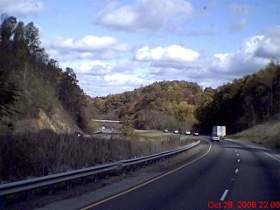Running Against The Governor - Another Form Of Engine Braking - How Does It Work Exactly?
Topic 7728 | Page 1
That is something that can actually get you in huge trouble at Prime. They never want to see your RMP's above 1500. They consider, according to their research, that engine damage occurs at 1800 RPM's and permanent damage occurs at 2000+ RPM's. Letting your RPM's get to 2500 for that governor is a sure way to lose a job here.
Now that's just Prime. But I personally wouldn't do it because of the risk of engine damage. They can see how you drive and they can attribute it to your drivings habits.
For me, the 5-3 procedure works just fine in bad conditions so I just stick with that.

Thanks Daniel. I know at my company they don't want the RPMs above 1500 either. So you're saying that usually the governor doesn't kick in till around 2500? I"m still trying to understand this.

This is what I've used when I can flip on the engine brake.
Oops. Meant to say the 5-3 is what I"ve used when I CAN'T flip on the engine brake.
Thanks Daniel. I know at my company they don't want the RPMs above 1500 either. So you're saying that usually the governor doesn't kick in till around 2500? I"m still trying to understand this.
I honestly don't know when this governor you speak of kicks in, if it even does. I've never let my RPM's get that high. I'll let you know on my last day at Prime.



Hey Daniel. Do you refrain from using your engine brake when it's raining, or even if the roads are wet? I know what schools teach, and I've stayed away from the engine brake unless the roads are dry. Period. I don't use it when it's raining, snowing, or during any kind of precipitation that would make the roads wet. I don't use it if it is not precipitating, but the roads are still wet. Am I being overcautious? Curious about what you and some other experienced drivers do on here.
OWI:
Operating While Intoxicated

Thanks Daniel. I know at my company they don't want the RPMs above 1500 either. So you're saying that usually the governor doesn't kick in till around 2500? I"m still trying to understand this.
I honestly don't know when this governor you speak of kicks in, if it even does. I've never let my RPM's get that high. I'll let you know on my last day at Prime.
Gotcha! Keep me in mind then before you give a notice, give it a whirl for me. 
Hey Daniel. Do you refrain from using your engine brake when it's raining, or even if the roads are wet? I know what schools teach, and I've stayed away from the engine brake unless the roads are dry. Period. I don't use it when it's raining, snowing, or during any kind of precipitation that would make the roads wet. I don't use it if it is not precipitating, but the roads are still wet. Am I being overcautious? Curious about what you and some other experienced drivers do on here.
Well, I would say you're doing the right thing. Doubles are very dangerous.
I'm slightly more relaxed with my engine braking. But remember, I can have up to 49,500lb of freight in my box. That's lots of grip, but also hard as heck to control using just the foot braking on a downgrade. So I'll use my engine braking if I have to.
If it hasn't rained in a while (as you know the first rain is slippery due to fluids on ground) then I won't use them. I won't use them in snow or ice. But if its just a light rain or slightly wet I'll use them. But never on a curve.
But then again it depends heavily on the weight of my load, not every load is above 45,000lb.
Doubles:
Refers to pulling two trailers at the same time, otherwise known as "pups" or "pup trailers" because they're only about 28 feet long. However there are some states that allow doubles that are each 48 feet in length.
OWI:
Operating While Intoxicated
Engine braking only goes to the drive anxles, nowhere else. Even on dry pavement, when the tractor slows down, the coasting momentum of the trailer will push on the tractor (through the single kingpin, which is made to swivel left and right.)
Without air braking, as the tractor slows through the drives, the trailer momentum keeps going forward. You know the thing about pushing a wet noodle? (It easily bends.) The trailer will want to do that, too, at the kingpin. Jackknife!
Use the brakes along with any engine breaking on slippery surfaces to help "drag" the trailer a bit to keep it in line. That doesn't necessarily mean you won't stop sweating bullets because of the slick road.

As a mechanic/driver, I see the governor as as a system that limits engine rpms by restricting fuel to the engine to keep it from going over the max setting of rpms. That being said, I don't thing it would act as an engine brake to help maintain a down hill, wet or dry. I think it would lead to an engine/truck speed runaway, either not good, like the more experienced drivers than me have said, I'd use the 5/3 , without engine brake on wet or snow.
New Reply:
New! Check out our help videos for a better understanding of our forum features

















Preview:








 TT On Facebook
TT On Facebook
Spring is on it's way, which means soggy weather and wet roads. This also means using caution when descending mountains, especially if the engine brake is not a viable option due to wet / slick roads.
What's the alternative to engine braking when descending a grade? You've got the 5-3 technique for starters. This is what I've used when I can flip on the engine brake. For those who need a refresher. Determine your safe speed. Apply the brakes gently for no more than 3 seconds at a time to reach 5 mph below your safe speed. Allow the truck to coast. Once the safe speed is reached again, apply the brakes again for no more than 3 seconds at a time. Rinse and repeat. If you're applying the brakes longer than 3 seconds, you're running the risk of heating them up, and are not following the 3 second rule. Safe speed is your max speed. The goal is to not go above that speed, and brake until you reach 5 mph below the safe speed. Hence, the 5-3 braking technique. Controlled braking (not stab braking) is incorporated in the 5-3.
The other option is to run against your governor. I believe I understand this in theory, but I'd like some experienced drivers to explain again for me please. From my understanding, you select a low gear and allow the rpms to reach high enough to 'bump up against' the governor, which then allows for a natural engine compression to occur, which will not allow your speed to increase ... correct? So you need to know what rpm / speed the governor kicks in specifically to what gear you've selected ... correct? And this method doesn't cause any damage? And you don't need to apply the brakes, similar to if you had selected the proper gear when descending a grade while using the engine brake?
HOS:
Hours Of Service
HOS refers to the logbook hours of service regulations.OWI:
Operating While Intoxicated